1. What is Automotive EMC?
Automotive EMC is a test to prevent unintentional radiation of automobiles from affecting motor vehicles and local electrical and electronic devices, and to protect motor vehicles, passengers, and other vehicle users from electromagnetic waves
Today's cars are made up of more sophisticated electronic components and systems than ever before. Additionally, new advances such as autonomous driving technology are using more and more sensors and electronics to enable connectivity and secure communication. Therefore, automotive electronics testing is essential to ensure that the components are safe and do not interfere with the safe operation of the vehicle. Automotive electronics testing ensures that every vehicle's electronic components withstand rigorous testing and comply with applicable regulatory and EMC testing standards.
2. Major Test Items
There are many test items in the safety field, but only the major test items are mentioned here.
| Name of test item | Summary of test | |
| EMI Electromagnetic Interference | RE (Radiated Emission) | Radiated noise emitted from electrical and electronic components/systems and the wiring harness connected thereto is measured in an electromagnetic wave anechoic test room. |
| CE (Conducted Emission) | Voltage Method Measures the henomenon in which electromagnetic noise generated from electric and electronic components/systems is emitted through power and ground wires through the monitoring terminal of the Aritficial Network Current Method Measures the amount of electromagnetic noise generated from electrical and electronic components/systems being conducted to the wiring harness outside the wiring using a Curent Measuring Probe. | |
| MFE (Magnetic Field Emission) | The magnetic field noiise emitted from electric and electronic components/systems is measured using a loop sensor with a built-in coil. | |
| CTE (VTE) (Conducted Transient Emission) | Regulates the transient voltage induced in the power line by the inductive load component of the components/systems to be evaluated. | |
| EMS Electromagnetic Susceptibility/Immunity | BCI (Bulk current injection) | As a test method to verify the immunity against electromagnetic waves introduced through the wiring harness of electromagnetic interference signal is applied to the wiring harness using an injection probe, and accordingly, it is determined whether the evaluation part is malfunctioning. |
| MFI (Magnetic Field Immunity) | After applying a magnetic field to electric and electronic components/systems by generating a magnetic field/using a coil, it is judged whether or not the evaluation parts/systems malfunction accordingly. | |
| CTI (Conducted Transient Immunity) | Evaluate the immunity performance of electrical and electronic components/systems against instantaneous transient voltage introduced into the power line. | |
| ESD (Electrostatic Discharge) | Check electrostatic, immunity to prevent static damage during assembly, transportation, and replacement of electrical and electronic components/systems. | |
| Handy Transmitter | The immunity performance of electric and electronic components and subsystems against electromagnetic interference generated from wireless transmitters such as GSM phones and general-purpise radios. |
3. Main facibilities
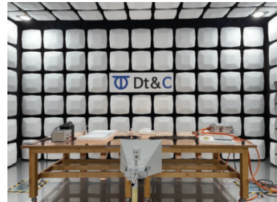 | Absorber lined Shielded Enclosure (EMI/EMS Chamber:1 System) | Radiated Emission 9 kHz ~ 8GHz Conducted Emission Voltage Method 100 kHz ~ 200 MHz Current Probe Method 20 Hz ~ 500 MHz Magnetic Field Emission 1 Hz -> 400 MHz Radiated Immunity ALSE 80 MHz ~ 6 GHz (200 V/m) |
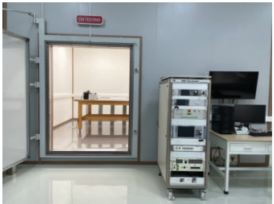 | Shield Room #1 BCI, MFI | Bulk Current Injection 10 kHz ~ 2.1 GHz Magnetic Field Immunity DC, 15 Hz ~ 1 MHz |
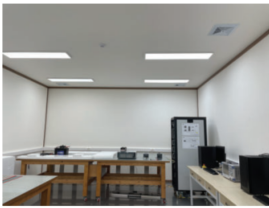 | Shield Room #2 CTI, ESD | Conducted Transient Immunity 12V/24V Systems Electrical Loads 12V/24V Systems: Voltage Transient Emission 12V/24V Systems Electrostatic Discharge |
4. Main Specifications
| Test scope | |
| E-Mark | ECE R-10.05, ECE R-97 |
| CISPR 25 | |
| KC Mark | KN41 |
| ISO Series | ISO 11452-1, ISO 11452-2, ISO 11452-4, ISO 11452-8, ISO 11452-9, ISO 7637-1, ISO 7637-2, ISO 7637-3, ISO 10605, ISO 16750-1, ISO 16750-2 |
| SAE Series | SAE J1113-4, SAE J1113-11, SAE J1113-12, SAE J1113-13, SAE J1113-21, SAE J1113-22, SAE J1113-41, SAE J1113-42 |
| VINFAST | VFDST00026302 VFDST00026303 VFDST00028121 |
| HYUNDAI-KIA | ES96200-00, ES96202-01,ES95400-10, ES96100-02 |
| SSANGYONG | SES E 922 |
| RENAULT | 36-00-808/--M |
| NISSAN | 28401NDS02 |
| GENERAL MOTORS | GMW3097 |
| FORD | FMC1278 |
| CHRYSLER | CS-11979 |
| Daimler AG | MBN 10284-2 |
| PSA PEUGEOT | B21 7110 |
| VOLVO | STD 515-0003, REQ-043878 |
| VOLKSWAGEN | TL 965, TL 82066, TL 82166, TL 82366, TL 82466, TL 82566, TL 81000 |
Common standards for Automotive EMC testing can be found here.







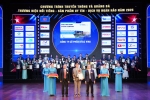
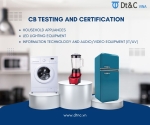
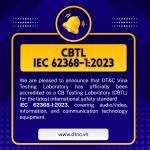

![[MIC] Officially issued QCVN 134:2024/BTTTT - National technical regulation on specific absorption levels for handheld and body-worn radio devices according to Circular 19/2024/TT-BTTTT of Ministry of Information and Communications](https://cdn0577.cdn4s.com/thumbs/qcvn-134_thumb_150.jpg)



![[Latest] Circular 02/2024/TT-BTTTT regulating the List of potentially unsafe products and goods under the management responsibility of the Ministry of Information and Communications](https://cdn0577.cdn4s.com/thumbs/trang-huy-hieu-the-loai-logo-2_thumb_150.jpg)